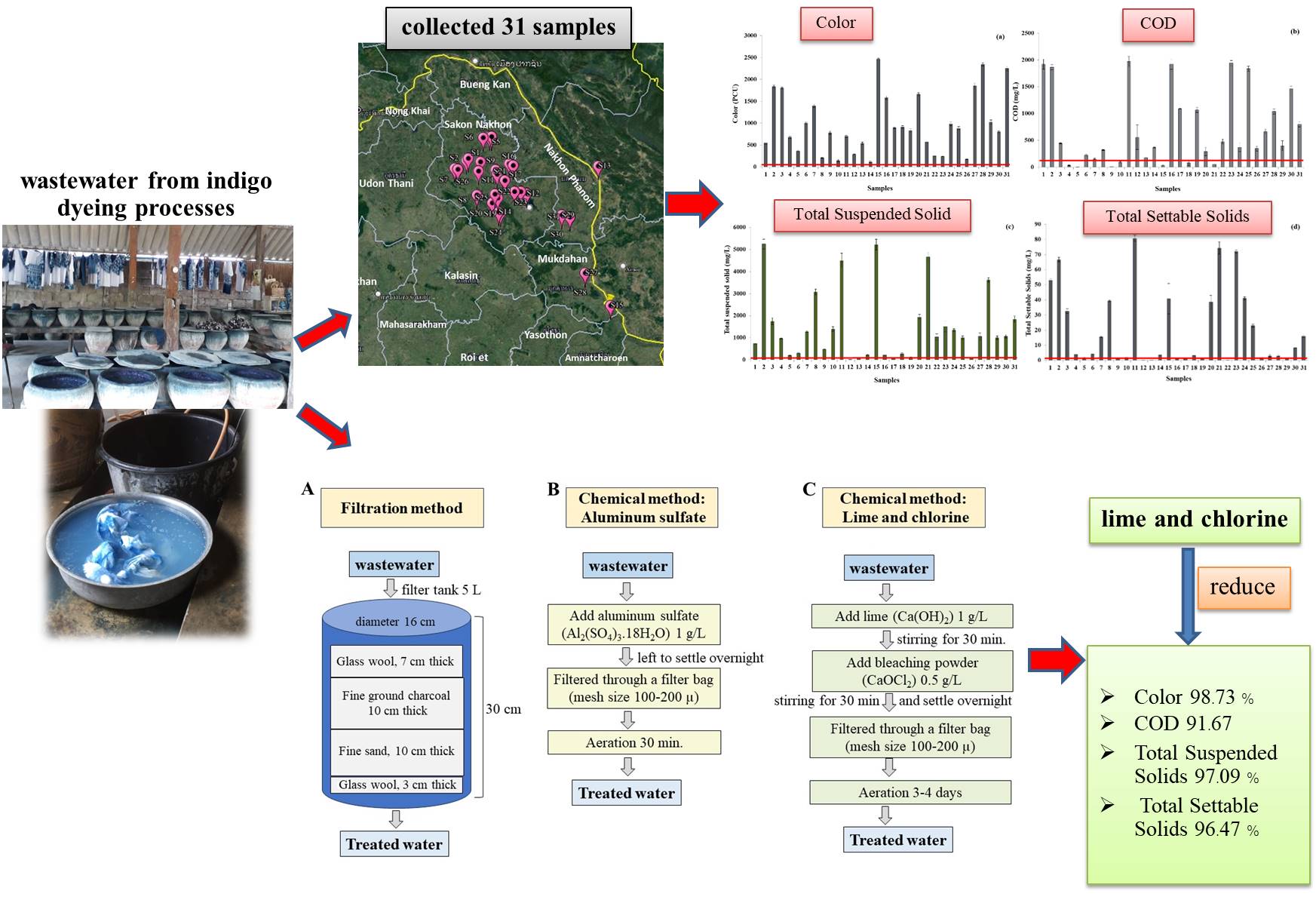Water Quality and Wastewater Treatment Methods from the Process of Dyeing Cloth with Indigo Dye in Northeastern Thailand
DOI:
https://doi.org/10.48048/tis.2024.7215Keywords:
Indigo dyeing wastewater, Total suspended solids, Water quality, Coagulants, CODAbstract
The process of producing indigo dyed cloth involves a step of washing the dyed cloth, which requires a large amount of water and generates wastewater that cannot be reused and may have negative impacts on the environment. This research study collected 31 samples of wastewater from the process of dyeing cloth with indigo dye from production sources in Sakon Nakhon, Nakhon Phanom, and Mukdahan provinces to analyze the water quality and study wastewater treatment methods at laboratory scale using filtration and chemical methods, which employed aluminum sulfate, lime, and chlorine as coagulants. From the study, it was found that the collected samples of wastewater from the process of dyeing cloth with indigo dye had water quality that exceeded the standards set by the Department of Pollution Control. The average color value was 1,040.86 ± 744.83 PCU, the average COD was 711.59 ± 695.07 mg/L, the average total suspended solid was 1,495.87 ± 1,583.17 mg/L, and the average of total settable solids was 20.52 ± 25.85 mg/L. Therefore, the wastewater should be treated before being discharged into the public water system. Regarding the treatment of wastewater from the dyeing process, it was found that the most effective method is chemical treatment using lime and chlorine, which can reduce color in the wastewater by 98.73 %, COD by 91.67 %, total suspended solids by 97.09 %, and total settable solids by 96.47 %. The 2nd-best method is the use of aluminum sulfate, followed by filtration. All in all, both methods of treating the dyed fabric wastewater can improve the water quality to meet the standard before being used for beneficial purposes or discharged into public water sources, and the appropriate method of treatment can be selected for each area to minimize environmental impact.
HIGHLIGHTS
- The analysis of the wastewater from indigo dyeing processes revealed that color, COD, total suspended solids, and total settable solids exceeded the wastewater standard
- The methods of treating the wastewater by chemical treatment using lime and chlorine, and aluminum sulfate can improve the water quality to meet the pollution standard
- The most effective method is chemical treatment using lime and chlorine
- This research provides a sustainable way to produce environmentally friendly natural-dyed fabrics
GRAPHICAL ABSTRACT
Downloads
Metrics
References
Y Minami, H Takao, T Kanafuji, K Miura, M Kondo, I Hara Nishimura, M Nishimura and H Matsubara. beta-Glucosidase in the indigo plant: Intracellular localization and tissue specific expression in leaves. Plant Cell Physiol. 1997; 38, 1069-74.
J Song, H Imanaka, K Imamura, K Kajitani and K Nakanishi. Development of a highly efficient indigo dyeing method using indican with an immobilized beta glucosidase from Aspergillus Niger. J. Biosci. Bioeng. 2010; 110, 281-7.
K Sukka, C Sompark, T Thanananta and N Sakkayawong. Isolation of bacteria from the indigo dyeing water in the dyed pot and indigo dyeing area soil for the application of dyeing process and wastewater treatment. Thai J. Sci. Tech. 2019; 8, 552-64.
S Barredo-Damas, MI Alcaina-Miranda, MI Iborra-Clar, A Bes-Pia, JA Mendoza-Roca and A Iborra-Clar. Study of the UF process as pretreatment of NF membranes for textile wastewater reuse. Desalination 2006; 200, 745-7.
C Cameselle, M Pazos and MA Sanroma´n. Selection of an electrolyte to enhance the electrochemical decolorization of indigo. Optimisation and scale-up. Chemosphere 2005; 60, 1080-6.
B Manu and S Chaudhari. Anaerobic decolorisation of simulated textile wastewater containing azo dyes. Bioresource Tech. 2002; 82, 225-31.
E Khelifi, H Bouallagui, Y Touhami, JJ Godon and M Hamdi. Enhancement of textile wastewater decolourization and biodegradation by isolated bacterial and fungal strains. Desalination Water Treat. 2009; 2, 319-25.
F Boran. Dye removing with dry and wet forms of pure bacterial cellulose produced by Gluconacetobacter xylinus. Comm. J. Biol. 2022; 6, 1-5.
A Bes-Pia, JA Mendoza-Roca, MI Alcaina-Miranda, A Iborra-Clar and MI Iborra-Clar. Combination of physico-chemical treatment and nanofiltration to reuse wastewater of a printing, dyeing and finishing textile industry. Desalination 2003; 157, 73-80.
TA Nguyen and RS Juang. Treatment of waters and wastewaters containing sulfur dyes: A review. Chem. Eng. J. 2013; 219, 109-17.
APHA. Standard methods for the examination of water and wastewater. American Public Health Association, Washington DC, 1980.
K Grasshoff, M Ehrhardt and K Kremling. Method of seawater analysis. Wiley-VCH, New York, 1983.
MN Abdallah and WSA Halim. Biochemical treatment of textile industrial wastewater. Int. J. Eng. Sci. Res. Tech. 2018; 7, 1-10.
N Senasri, P Sriyasak, S Suwanpakdee, N Chumnanka, P Tongkasee and K Sriputhorn. Toxicity of indigo dye-contaminated water on silver barbs (Barbonymus gonionotus) and pathology in the gills. EnvironmentAsia J. 2022; 15, 106-15.
Pollution Control Department: Law and Water Quality Standard, Available at: https://www.pcd.go.th/
lawstype, accessed April 2023.
G Dogdu and A Yalcuk. Indigo dyeing wastewater treatment by eco-friendly constructed wetlands using different bedding media. Desalination Water Treat. 2015; 57, 1-13.
M Unlu, H Yukseler and U Yetis. Indigo dyeing wastewater reclamation by membrane-based filtration and coagulation processes. Desalination 2009; 240, 178-85.
B Manu. Physico-chemical treatment of indigo dye wastewater. Coloration Tech. 2007; 123, 197-202.

Downloads
Published
How to Cite
Issue
Section
License
Copyright (c) 2023 Walailak University

This work is licensed under a Creative Commons Attribution-NonCommercial-NoDerivatives 4.0 International License.






